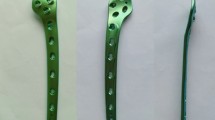Abstract
Background
A new device for the treatment of femoral neck fractures that uses 2 cephalocervical screws in a sliding mechanism allowing linear intraoperative and postoperative compression has been developed. The purpose of this retrospective study was to determine the results using this device for the treatment of stable and unstable femoral neck fractures.
Methods
Between November 2007 and November 2011, 61 consecutive skeletally mature patients with femoral neck fractures were treated with a new cephalocervical screw (Dual SC screw; KISCO DIR Co., Ltd., Kobe). All contactable patients were followed up for a minimum of 16 weeks postoperatively (range 16–123 weeks). Clinical and radiographic examinations were performed at the final evaluation. Healing and return to activities of daily living were used to evaluate outcomes.
Results
There were 51 women and 10 men with a mean age of 80.8 years (range, 41–99). The average of surgical time was 33.1 min (21–66 min). One patient died, one was too infirm for follow-up, and eleven could not be located, leaving 48 patients available for final evaluation (78.7 %). The overall incidence of nonunion was 10.4 %. Fracture nonunion was less common for undisplaced fractures than for displaced fractures (1 of 21 [4.8 %] vs. 4 of 27 [14.8 %]). The mean amount of collapse of the neck was 5.45 mm (3.92 mm in undisplaced and 6.64 mm in displaced). Radiographic analysis at final evaluation revealed no implant failures. 62.5 % of the patients recovered their prefracture status.
Conclusion
The Dual SC screw device appears to be a reliable implant for the treatment of femoral neck fractures. Its design contributes to overcome the implant failures such as a medial migration, cut-out, or back-out; besides, the union rate of this implant was considered superior to that of existing systems. If the early shortening of the neck occurs after this surgery, the surgeons should be considered to keep them partially weight bearing or choose a replacement procedure for such patients.


Similar content being viewed by others
References
Orimo H, Hashimoto T, Sakata K, Yoshimura N, Suzuki T, Hosoi T (2000) Trends in the incidence of hip fracture in Japan, 1987–1997: the third nationwide survey. J Bone Miner Metab 18:126–131
Popovic JR (2001) 1999 National Hospital Discharge Survey: annual summary with detailed diagnosis and procedure data. Vital Health Statist 13:151
Bhandari M, Devereaux PJ, Swiontkowski MF, Tornetta P 3rd, Obremskey W, Koval KJ, Nork S, Sprague S, Schemitsch EH, Guyatt GH (2003) Internal fixation compared with arthroplasty for displaced fractures of the femoral neck. A meta-analysis. J Bone Joint Surg Am 85-A:1673–1681
Healy WL, Iorio R (2004) Total hip arthroplasty: optimal treatment for displaced femoral neck fractures in elderly patients. Clin Orthop Relat Res 429:43–48
Rogmark C, Carlsson A, Johnell O, Sembo I (2003) Costs of internal fixation and arthroplasty for displaced femoral neck fractures: a randomized study of 68 patients. Acta Orthop Scand 74:293–298
Lykke N, Lerud PJ, Strømsøe K, Thorngren KG (2003) Fixation of fractures of the femoral neck. A prospective, randomised trial of three Ullevaal hip screws versus two Hansson hook-pins. J Bone Joint Surg Br 85:426–430
Olerud C, Rehnberg L, Hellquist E (1991) Internal fixation of femoral neck fractures. Two methods compared. J Bone Joint Surg Br 73:16–19
Mjørud J, Skaro O, Solhaug JH, Thorngren KG (2006) A randomised study in all cervical hip fractures osteosynthesis with Hansson hook-pins versus AO-screws in 199 consecutive patients followed for two years. Injury 37:768–777
Strömqvist B, Nilsson LT, Thorngren KG (1992) Femoral neck fracture fixation with hook-pins. 2-year results and learning curve in 626 prospective cases. Acta Orthop Scand 63:282–287
Parker MJ, Blundell C (1998) Choice of implant for internal fixation of femoral neck fractures. Meta-analysis of 25 randomised trials including 4,925 patients. Acta Orthop Scand 69:138–143
Parker MJ, Stockton G (2001) Internal fixation implants for intracapsular proximal femoral fractures in adults. Cochrane Database Syst Rev, 4, CD001467
Ogura A, Mori G, Kai H, Tanahashi K, Kitada K (2010) Treatment of femoral neck fractures with Dual SC screw system. Kossetsu 32:567–569 (in Japanese)
Conflict of interest
No benefits in any form have been or will be received from a commercial party related directly or indirectly to the subject of this manuscript.
Author information
Authors and Affiliations
Corresponding author
Rights and permissions
About this article
Cite this article
Nishiyama, D., Matsumoto, T. & Hamazaki, H. The treatment of femoral neck fractures: results using cephalocervical screws with sliding mechanism. Eur J Orthop Surg Traumatol 23, 907–911 (2013). https://doi.org/10.1007/s00590-012-1103-z
Received:
Accepted:
Published:
Issue Date:
DOI: https://doi.org/10.1007/s00590-012-1103-z




